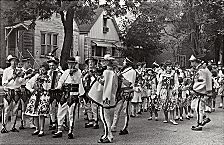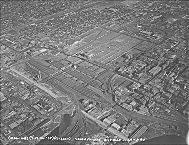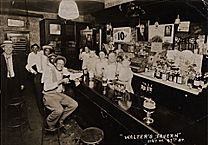|
Polish Mountaineers' Parade, 1965

|
Situated in a heavily industrialized location, populated by successive generations of immigrant people, and animated by some of the most dramatic social conflicts of modern times, Back of the Yards focused the attention of novelists, activists, and social scientists alike for most of the twentieth century. Located in the
community area
of
New City,
the neighborhood extends from 39th to 55th Streets between Halsted and the railroad tracks along Leavitt Street, just south and west of the former
Union Stock Yard
and adjacent packing plants, a giant sprawl that was until the 1950s the largest livestock yards and
meatpacking
center in the country.
Aerial: Union Stock Yard, 1936

|
The concentration of
railroads
in the mid-nineteenth century, the establishment of the Union Stock Yard in 1865, and the perfection of the refrigerated boxcar by 1880 led to a giant expansion of meatpacking in the neighborhood. Part of the town of Lake until
annexation
by Chicago in 1889, Back of the Yards was settled by skilled
Irish
and
German
butchers, joined in the 1870s and 1880s by
Czechs.
Here in 1889, developer Samuel Gross built one of his earliest
subdivisions
of cheap workingmen's cottages. By the turn of the century the area was transformed into a series of Slavic enclaves dominated by
Poles,
Lithuanians,
Slovaks,
and Czechs, with most communities organized around ethnic
parishes
serving as social and cultural as well as spiritual focal points for residents' lives. Small numbers of
Mexican
immigrants entered Back of the Yards and neighboring
Bridgeport
as early as World War I and the 1920s, but the community retained its Slavic character until the 1970s, when it gradually became a largely Chicano community with a minority of
African Americans.
Immortalized for its pollution, squalor, and poverty in Upton Sinclair's
The
Jungle
(1906), government reports, and
University of Chicago
sociology studies, Back of the Yards was, in fact, characterized by particularly vibrant and cohesive working-class communities over time. The sprawling stockyards and adjacent plants with their unique combination of pollution, erratic
work
schedules, occupational diseases, and low wages exacted a heavy toll on the community in the years up to the
Great Depression,
but workers and their families organized a series of struggles in and outside the plants to improve and protect their communities.
Zielinski Tavern, c.1933

|
In the Depression and World War II years residents created two key social movements: the Packinghouse Workers Organizing Committee (later the United Packinghouse Workers of America, or UPWA-CIO) and
Back of the Yards Neighborhood Council
(BYNC). The UPWA-CIO, a particularly effective industrial union movement, became a progressive mainstay of the labor movement. The BYNC, a coalition of dozens of neighborhood and parish groups, became Saul Alinsky's model for
community organizing
throughout the country. While the UPWA-CIO raised wages, stabilized employment, and fought for
civil rights
in the plants, the BYNC galvanized a broader community identity among the diverse ethnic groups and addressed an array of community problems.
With the end of Chicago's meatpacking industry by the 1960s, Back of the Yards once again faced serious problems of economic decline and physical deterioration. At the end of the twentieth century, as the city worked to develop a new manufacturing district on the site of the old Union Stock Yard, the newer residents resumed the old struggle to maintain a strong community.
James R. Barrett
Bibliography
Barrett, James R.
Work and Community in the Jungle: Chicago's Packinghouse Workers, 1894–1922.
1987.
Jablonsky, Thomas J.
Pride in the Jungle: Community and Everyday Life in Back of the Yards Chicago.
1993.
Slayton, Robert A.
Back of the Yards: The Making of a Local Democracy.
1986.
|


